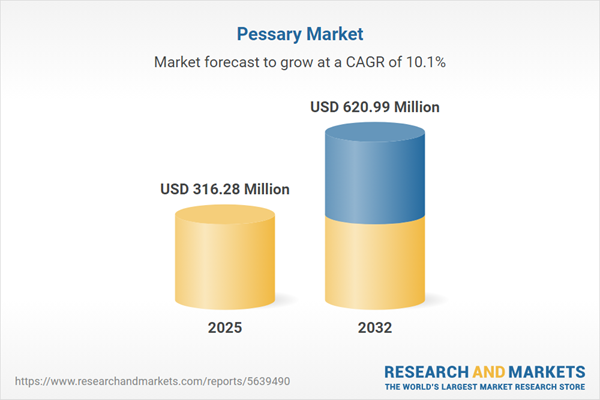Speak directly to the analyst to clarify any post sales queries you may have.
The pessary market is evolving as organizations strategize to meet shifting pelvic health needs, integrate new technologies, and navigate complex healthcare environments. Senior decision-makers are leveraging advancements in clinical innovation and care delivery to build competitive positions in this dynamic sector.
Market Snapshot: Pessary Market Growth Overview
The global pessary market is experiencing sustained growth, with a 2024 valuation of USD 287.73 million and a projection to reach USD 316.28 million in 2025. By 2032, the market is forecasted to achieve USD 620.99 million, reflecting a CAGR of 10.09%. This momentum is being driven by ongoing clinical practice enhancements, diversification of pelvic health solutions, and increased emphasis on professional and patient education. Engagement from established and emerging healthcare systems is shaping collaborative strategies, enabling organizations to broaden and refine product portfolios and strengthen market positioning.
Pessary Market Scope & Segmentation
- Product Types: Cube pessaries address mild pelvic organ prolapse and provide accessible pathways for early-stage intervention. Gellhorn pessaries deliver advanced anatomical support due to their specialized features. Inflatable pessaries enable customization and added comfort for a diverse patient population. Introl pessaries expand post-insertion for enhanced placement and treatment consistency. Ring pessaries remain widely adopted owing to their reliability and clinician familiarity.
- Material Types: Latex pessaries offer flexibility over numerous indications. Silicone options enhance safety for patients with sensitivities and provide compatibility advantages. Thermoplastic elastomers combine long-term durability with improved comfort, supporting sustained management.
- Applications: Pessaries present a primary non-surgical solution for pelvic organ prolapse and extend their use to stress urinary incontinence, reinforcing the role of conservative therapies within pelvic and urogynecology care.
- End Users: Hospitals, ambulatory surgical centers, outpatient clinics, and home healthcare services utilize pessaries within integrated approach models targeting holistic pelvic health outcomes.
- Distribution Channels: Direct supply ensures rapid access for institutional providers. Online platforms continue to gain ground as telehealth adoption drives remote care preferences and expands market accessibility.
- Regional Markets: North America, Latin America, Europe, Middle East, Africa, and Asia-Pacific represent distinct regulatory, training, and reimbursement environments. Tailored regional strategies are becoming essential in responding to unique adoption trends and care delivery frameworks.
- Technologies: Progress in biocompatible polymers and cutting-edge thermoplastics is improving customization and product reliability. 3D printing enables device adaptation at the point of need, and digital tools facilitate remote fitting, ongoing monitoring, and patient education both in clinics and at home.
Key Takeaways for Decision Makers
- Material innovations contribute to improved patient satisfaction, support streamlined clinical workflows, and help optimize device performance across diverse care settings.
- Telehealth platforms and remote-monitoring technology are being integrated to enable timely decision-making and facilitate scalable training for both healthcare professionals and patients.
- Regulatory changes are accelerating the adoption of digital tools and reinforcing the need for proactive compliance strategies and rapid operational adjustment.
- Expanding supply chain strategies, including procurement from multiple sources, enhances resilience and addresses risks associated with changing global healthcare trade and compliance dynamics.
- Strategic partnerships among manufacturers, technology providers, and distribution networks foster development of superior, differentiated pelvic health solutions and sharpen competitive differentiation.
Tariff Impact on the United States Pessary Market
Recent changes in medical device tariffs are prompting U.S.-based pessary manufacturers to reconsider sourcing and manufacturing frameworks. Many organizations are focusing on flexible supply chains and group purchasing arrangements to increase agility while maintaining their position in a shifting trade environment.
Research Methodology & Data Sources
This analysis draws on interviews with clinicians, device producers, and procurement specialists within pelvic health. Data interpretation is supported by peer-reviewed literature, regulatory documentation, and authoritative industry reports to ensure actionable, reliable insights for leadership teams.
Why This Report Matters
- Executive decision-makers receive clear benchmarks and industry context to inform strategic planning in the pessary market.
- Transparency on regulatory shifts, technology direction, and supply challenges supports risk-aware product and operational choices.
- Senior leaders are equipped with frameworks for targeted risk assessment and the identification of growth opportunities across diverse regional healthcare environments.
Conclusion
Innovations in materials, digital integration, and market strategies are redefining the pessary landscape. Successful leadership will require informed action to ensure resilience and capitalize on sustained pelvic health sector growth.
Additional Product Information:
- Purchase of this report includes 1 year online access with quarterly updates.
- This report can be updated on request. Please contact our Customer Experience team using the Ask a Question widget on our website.
Table of Contents
3. Executive Summary
4. Market Overview
7. Cumulative Impact of Artificial Intelligence 2025
Companies Mentioned
The companies profiled in this Pessary market report include:- Dr. Arabin GmbH & Co. KG
- Laborie Medical Technologies Corp.
- CooperCompanies, Inc.
- Boston Scientific Corporation
- Coloplast A/S
- Medtronic PLC
- Cosm Medical Corp.
- FemTherapeutics Inc.
- Bliss GVS Pharma Ltd.
- Bray Healthcare
Table Information
| Report Attribute | Details |
|---|---|
| No. of Pages | 191 |
| Published | November 2025 |
| Forecast Period | 2025 - 2032 |
| Estimated Market Value ( USD | $ 316.28 Million |
| Forecasted Market Value ( USD | $ 620.99 Million |
| Compound Annual Growth Rate | 10.0% |
| Regions Covered | Global |
| No. of Companies Mentioned | 11 |









